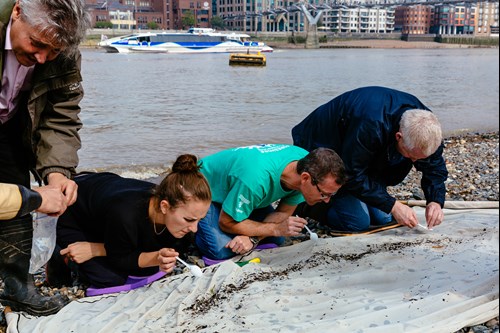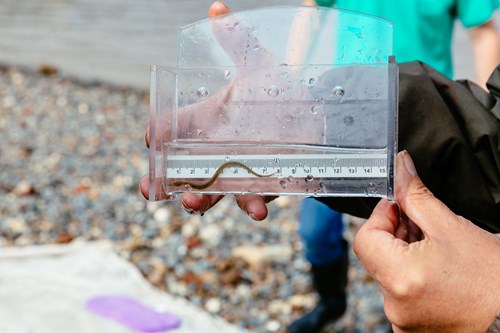Thames ecology research programme
As part its legacy programme Tideway has funded research into the ecology of the tidal Thames - the fish, seals and other species that call the river home. Some of these reports provide baseline data which will provide comparisons for future research into the river and its wildlife.
How artificial habitat structures help fish migrate through the tidal Thames
by THA Aquatic Ltd, published February 2017.
Fish use the tidal Thames as a nursery area and migration route but development has narrowed the river in places. This has led to an increase in the speed and turbulence of the water, increasing the risk that smaller fish may not be able to swim up the river or may be delayed doing so - which can ultimately harm fish stocks. THA Aquatic investigated whether artificial habitat structures on the edge of the river could help fish to swim more freely by providing a ‘refuge’ point when the outgoing tide is at its strongest. The researchers found that the fish who used these structures were more likely to hold their position, demonstrating the value of current design guidelines which state that artificial habitat structures should be considered by those developing in or near the river. You can read the report in full here.
‘Early life stage’ fish in the tidal Thames
by the Zoological Society of London (ZSL), Bournemouth University and SC², published August 2019
This study was commissioned by Tideway to obtain pre-Thames Tideway Tunnel baseline data on the fish in the estuary. It focused on the ‘early life stage’ of fish (eggs, larvae and juvenile) - the most abundant, vulnerable and understudied types of fish in the tidal river. Sampling took place during 2017 and 2018 at Putney and Greenwich. A total of 8,263 fish were caught, comprising 25 different species. The data showed the full width of the channel was used as a nursery ground for fish - some species appeared to favour the mid-channel, others move to the edge of the river as they develop. It represents the most comprehensive research of fish at this life stage on any UK estuary to date and demonstrated the importance of the Thames as a nursery habitat. Community volunteering was part of the research project so ‘citizen science’ surveys were held on the foreshore at Blackfriars. The methodology used in the study can be replicated, allowing future surveys to be compared with these findings. You can read the report in full here.

Smelt surveys on the tidal Thames
by ZSL, Bournemouth University and SC², published December 2020.
This research built on previous studies and drew on the findings of the early life stage fish study. European smelt fish migrate up estuaries from the sea to spawn and their presence can be used as an indicator of good water quality due to their sensitivity to pollution. Previous research had identified a potential spawning area upstream of Wandsworth Bridge and Tideway commissioned further research to develop understanding of use of the upper estuary for smelt spawning when construction works were taking place. The previous surveys showed the area between Putney and Battersea recorded smelt spawning every year except for 2018. These further surveys showed that spawning in this part of the river did not occur in 2019 but did in 2020. During 2018 and 2019 percussive piling works were taking place at some Tideway sites suggesting that this may have impacted their migratory patterns and spawning activity. You can read the report in full here.

Levels of microplastics in the tidal Thames (using Tideway-funded report data)
by the Natural History Museum, Royal Holloway London and ZSL, published October 2020.
In addition to directly-funded reports, data gathered by ZSL in the studies on early life stage fish was used by researchers studying levels of microplastics in the river. The study found that the Thames has some of the highest recorded levels of microplastics for any river in the world. Secondary microplastics, namely films and fragments, were the most abundant plastic - 93.5% of all microplastics. Combined sewer overflows were identified as a crucial link for carrying microplastics , particularly with respect to microfibres, glitter and microbeads which are found in cosmetic products. Tideway was identified as a much-needed project to help reduce this pollutant. Full report published in the scientific journal ‘Science of the Total Environment’ can be seen here.
ZSL Marine Mammal Monitoring
ZSL have an ongoing programme of marine mammal monitoring and undertake annual seal population surveys. In 2018 Tideway contributed funds to enable a seal breeding survey to take place that year for the first time since 2011. The survey showed clear evidence that harbour seals are breeding in growing numbers in the river - a total of 138 pups were recorded during the pup-count, an increase at all sites compared with 2011. You can find more on this here.
